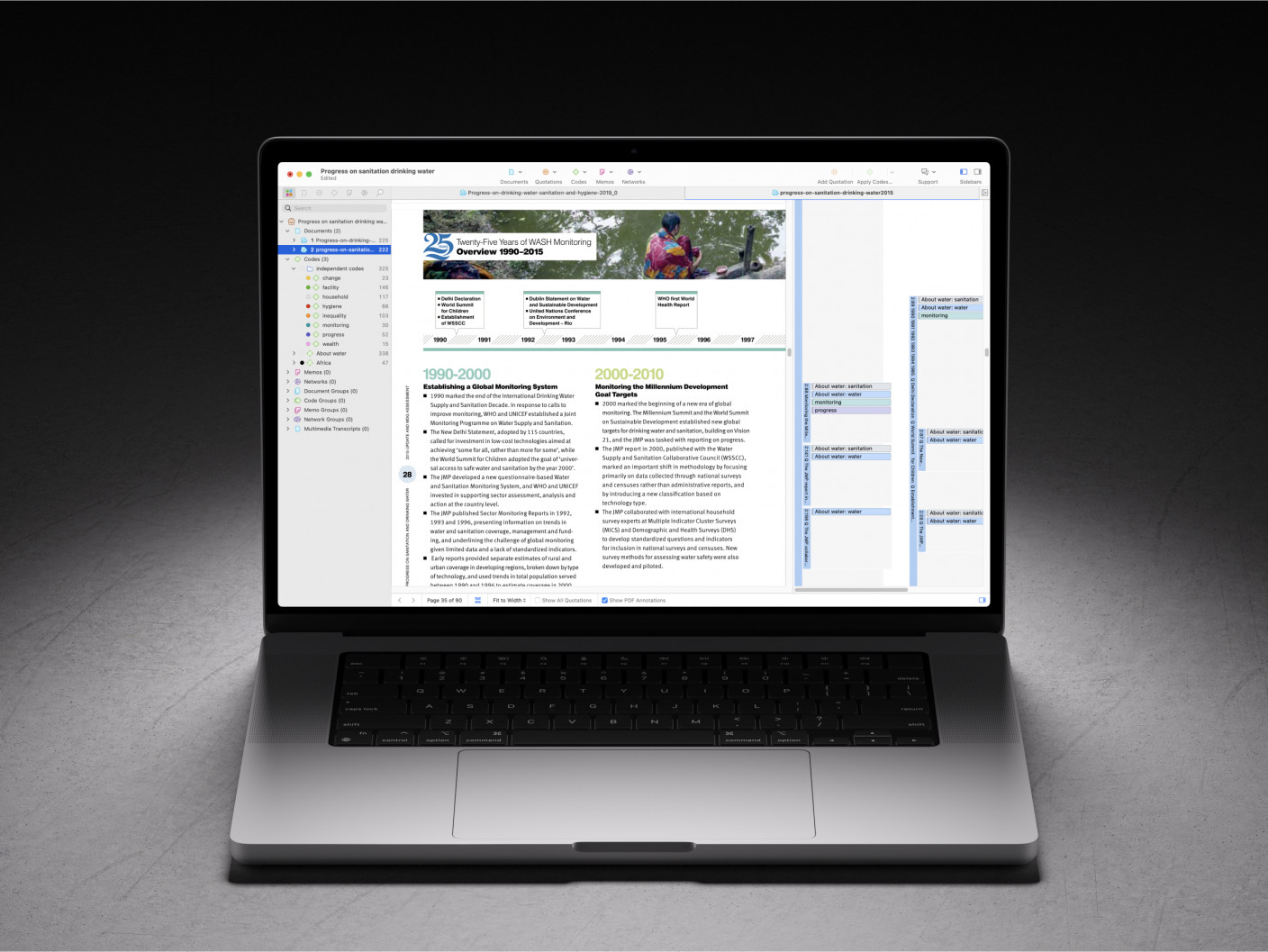- Handling qualitative data
- Transcripts
- Field notes
- Memos
- Survey data and responses
- Visual and audio data
- Data organization
- Data coding
- Coding frame
- Auto and smart coding
- Organizing codes
- Qualitative data analysis
- Content analysis
- Thematic analysis
- Narrative research
- Phenomenological research
- Discourse analysis
- Grounded theory
- Deductive reasoning
- Inductive reasoning
- Inductive vs. deductive reasoning
- Qualitative data interpretation
- Qualitative data analysis software
- How to cite "The Ultimate Guide to Qualitative Research - Part 2"
- Thematic analysis vs. content analysis
Narrative analysis in research
Narrative analysis is an approach to qualitative research that involves the documentation of narratives both for the purpose of understanding events and phenomena and understanding how people communicate stories.

Let's look at the basics of narrative research, then examine the process of conducting a narrative inquiry and how ATLAS.ti can help you conduct a narrative analysis.
Types of narrative research
Qualitative researchers can employ various forms of narrative research, but all of these distinct approaches utilize perspectival data as the means for contributing to theory.
Biography
A biography is the most straightforward form of narrative research. Data collection for a biography generally involves summarizing the main points of an individual's life or at least the part of their history involved with events that a researcher wants to examine. Generally speaking, a biography aims to provide a more complete record of an individual person's life in a manner that might dispel any inaccuracies that exist in popular thought or provide a new perspective on that person’s history. Narrative researchers may also construct a new biography of someone who doesn’t have a public or online presence to delve deeper into that person’s history relating to the research topic.
The purpose of biographies as a function of narrative inquiry is to shed light on the lived experience of a particular person that a more casual examination of someone's life might overlook. Newspaper articles and online posts might give someone an overview of information about any individual. At the same time, a more involved survey or interview can provide sufficiently comprehensive knowledge about a person useful for narrative analysis and theoretical development.
Life history
This is probably the most involved form of narrative research as it requires capturing as much of the total human experience of an individual person as possible. While it involves elements of biographical research, constructing a life history also means collecting first-person knowledge from the subject through narrative interviews and observations while drawing on other forms of data, such as field notes and in-depth interviews with others.
Even a newspaper article or blog post about the person can contribute to the contextual meaning informing the life history. The objective of conducting a life history is to construct a complete picture of the person from past to present in a manner that gives your research audience the means to immerse themselves in the human experience of the person you are studying.
Oral history
While all forms of narrative research rely on narrative interviews with research participants, oral histories begin with and branch out from the individual's point of view as the driving force of data collection.
Major events like wars and natural disasters are often observed and described at scale, but a bird's eye view of such events may not provide a complete story. Oral history can assist researchers in providing a unique and perhaps unexplored perspective from in-depth interviews with a narrator's own words of what happened, how they experienced it, and what reasons they give for their actions. Researchers who collect this sort of information can then help fill in the gaps common knowledge may not have grasped.
The objective of an oral history is to provide a perspective built on personal experience. The unique viewpoint that personal narratives can provide has the potential to raise analytical insights that research methods at scale may overlook. Narrative analysis of oral histories can hence illuminate potential inquiries that can be addressed in future studies.
Research methods for a narrative analysis
To conduct narrative analysis, researchers need a narrative and research question. A narrative alone might make for an interesting story that instills information, but analyzing a narrative to generate knowledge requires ordering that information to identify patterns, intentions, and effects.
Narrative analysis presents a distinctive research approach among various methodologies, and it can pose significant challenges due to its inherent interpretative nature. Essentially, this method revolves around capturing and examining the verbal or written accounts and visual depictions shared by individuals. Narrative inquiry strives to unravel the essence of what is conveyed by closely observing the content and manner of expression.
Furthermore, narrative research assumes a dual role, serving both as a research technique and a subject of investigation. Regarded as "real-world measures," narrative methods provide valuable tools for exploring actual societal issues. The narrative approach encompasses an individual's life story and the profound significance embedded within their lived experiences. Typically, a composite of narratives is synthesized, intermingling and mutually influencing each other.

Designing a research inquiry
Sometimes, narrative research is less about the storyteller or the story they are telling than it is about generating knowledge that contributes to a greater understanding of social behavior and cultural practices. While it might be interesting or useful to hear a comedian tell a story that makes their audience laugh, a narrative analysis of that story can identify how the comedian constructs their narrative or what causes the audience to laugh.
As with all research, a narrative inquiry starts with a research question that is tied to existing relevant theory regarding the object of analysis (i.e., the person or event for which the narrative is constructed). If your research question involves studying racial inequalities in university contexts, for example, then the narrative analysis you are seeking might revolve around the lived experiences of students of color. If you are analyzing narratives from children's stories, then your research question might relate to identifying aspects of children's stories that grab the attention of young readers.
The point is that researchers conducting a narrative inquiry do not do so merely to collect more information about their object of inquiry. Ultimately, narrative research is tied to developing a more contextualized or broader understanding of the social world.
Data collection
Having crafted the research questions and chosen the appropriate form of narrative research for your study, you can start to collect your data for the eventual narrative analysis.

Needless to say, the key point in narrative research is the narrative. The story is either the unit of analysis or the focal point from which researchers pursue other methods of research. Interviews and observations are great ways to collect narratives. Particularly with biographies and life histories, one of the best ways to study your object of inquiry is to interview them. If you are conducting narrative research for discourse analysis, then observing or recording narratives (e.g., storytelling, audiobooks, podcasts) is ideal for later narrative analysis.
Triangulating data
If you are collecting a life history or an oral history, then you will need to rely on collecting evidence from different sources to support the analysis of the narrative. In research, triangulation is the concept of drawing on multiple methods or sources of data to get a more comprehensive picture of your object of inquiry.
While a narrative inquiry is constructed around the story or its storyteller, assertions that can be made from an analysis of the story can benefit from supporting evidence (or lack thereof) collected by other means.
Even a lack of supporting evidence might be telling. For example, suppose your object of inquiry tells a story about working minimum wage jobs all throughout college to pay for their tuition. Looking for triangulation, in this case, means searching through records and other forms of information to support the claims being put forth. If it turns out that the storyteller's claims bear further warranting - maybe you discover that family or scholarships supported them during college - your analysis might uncover new inquiries as to why the story was presented the way it was. Perhaps they are trying to impress their audience or construct a narrative identity about themselves that reinforces their thinking about who they are. The important point here is that triangulation is a necessary component of narrative research to learn more about the object of inquiry from different angles.
Narrative analysis
This brings us to the analysis part of narrative research. As explained above, a narrative can be viewed as a straightforward story to understand and internalize. As researchers, however, we have many different approaches available to us for analyzing narrative data depending on our research inquiry.
In this section, we will examine some of the most common forms of analysis while looking at how you can employ tools in ATLAS.ti to analyze your qualitative data.
Thematic analysis
Qualitative research often employs thematic analysis, which refers to a search for commonly occurring themes that appear in the data. The important point of thematic analysis in narrative research is that the themes arise from the data produced by the research participants. In other words, the themes in a narrative study are strongly based on how the research participants see them rather than focusing on how researchers or existing theory see them.
ATLAS.ti can be used for thematic analysis in any research field or discipline. Data in narrative research is summarized through the coding process, where the researcher codes large segments of data with short, descriptive labels that can succinctly describe the data thematically. The emerging patterns among occurring codes in the perspectival data thus inform the identification of themes that arise from the collected narratives.
Structural analysis
The search for structure in a narrative is less about what is conveyed in the narrative and more about how the narrative is told. The differences in narrative forms ultimately tell us something useful about the meaning-making epistemologies and values of the people telling them and the cultures they inhabit.
Just like in thematic analysis, codes in ATLAS.ti can be used to summarize data, except that in this case, codes could be created to specifically examine structure by identifying the particular parts or moves in a narrative (e.g., introduction, conflict, resolution). Code-Document Analysis in ATLAS.ti can then tell you which of your narratives (represented by discrete documents) contain which parts of a common narrative.
It may also be useful to conduct a content analysis of narratives to analyze them structurally. English has many signal words and phrases (e.g., "for example," "as a result," and "suddenly") to alert listeners and readers that they are coming to a new step in the narrative.
In this case, both the Text Search and Word Frequencies tools in ATLAS.ti can help you identify the various aspects of the narrative structure (including automatically identifying discrete parts of speech) and the frequency in which they occur across different narratives.
Functional analysis
Whereas a straightforward structural analysis identifies the particular parts of a narrative, a functional analysis looks at what the narrator is trying to accomplish through the content and structure of their narrative. For example, if a research participant telling their narrative asks the interviewer rhetorical questions, they might be doing so to make the interviewer think or adopt the participant's perspective.
A functional analysis often requires the researcher to take notes and reflect on their experiences while collecting data from research participants. ATLAS.ti offers a dedicated space for memos, which can serve to jot down useful contextual information that the researcher can refer to while coding and analyzing data.
Dialogic analysis
There is a nuanced difference between what a narrator tries to accomplish when telling a narrative and how the listener is affected by the narrative. There may be an overlap between the two, but the extent to which a narrative might resonate with people can give us useful insights about a culture or society.
The topic of humor is one such area that can benefit from dialogic analysis, considering that there are vast differences in how cultures perceive humor in terms of how a joke is constructed or what cultural references are required to understand a joke.
Imagine that you are analyzing a reading of a children's book in front of an audience of children at a library. If it is supposed to be funny, how do you determine what parts of the book are funny and why?
The coding process in ATLAS.ti can help with dialogic analysis of a transcript from that reading. In such an analysis, you can have two sets of codes, one for thematically summarizing the elements of the book reading and one for marking when the children laugh.
The Code Co-Occurrence Analysis tool can then tell you which codes occur during the times that there is laughter, giving you a sense of what parts of a children's narrative might be funny to its audience.
Considerations for narrative analysis
Narrative analysis and research hold immense significance within social science research, contributing a distinct and valuable approach. Whether employed as a component of a comprehensive presentation or pursued as an independent scholarly endeavor, narrative research merits recognition as a distinctive form of research and interpretation in its own right.
Subjectivity in narratives

Researchers conducting narrative research should acknowledge that every narrative is intricately intertwined with its cultural milieu and the subjective experiences of the storyteller. While the outcomes of research are undoubtedly influenced by the individual narratives involved, a conscientious adherence to narrative methodology and a critical reflection on one's research can foster transparent and rigorous investigations, minimizing the potential for misunderstandings.
Rather than striving to perceive narratives through an objective lens, it is imperative to contextualize them within their sociocultural fabric. By doing so, an analysis can embrace the diverse array of narratives and enable multiple perspectives to illuminate a phenomenon or story. Embracing such complexity, narrative methodologies find considerable application in social science research.
Connecting narratives to broader phenomena
In employing narrative analysis, researchers look at personal narratives and carefully consider the multifaceted interplay between individual experiences and broader societal dynamics.
This meticulous approach fosters a deeper understanding of the intricate web of meanings that shape the narratives under examination. Consequently, researchers can uncover rich insights and discern patterns that may have remained hidden otherwise. These can provide valuable contributions to both theory and practice.
In summary, narrative analysis occupies an important position within social science research. By appreciating the cultural embeddedness of narratives, employing a thoughtful methodology, and critically reflecting on one's research, scholars can conduct robust investigations that shed light on the complexities of human experiences while avoiding potential pitfalls and fostering a nuanced understanding of the narratives explored.



